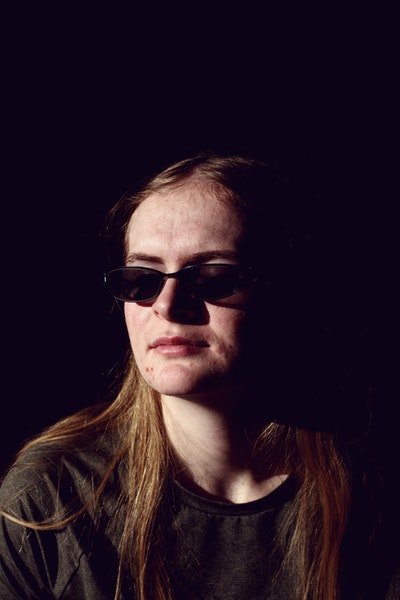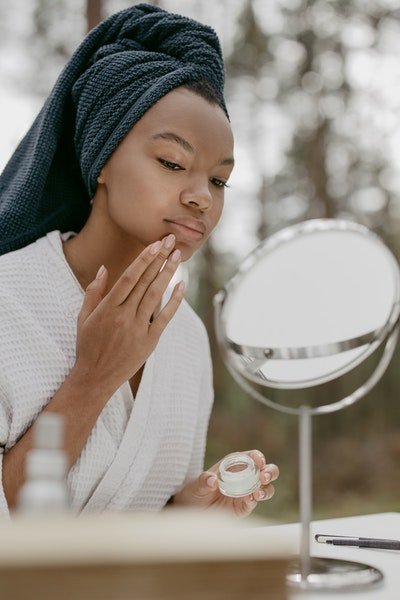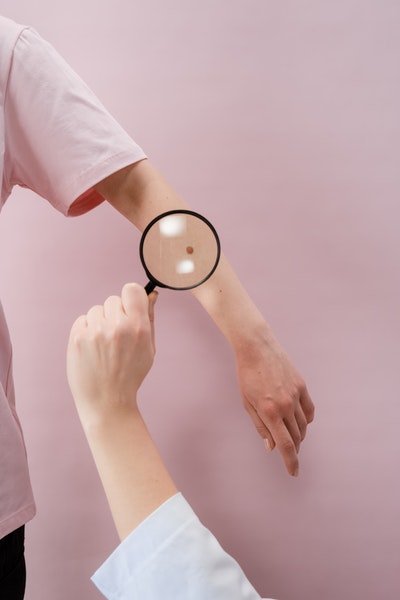Imagine you need to leave the house, but as soon as you wake up, you notice you have large red patches on your face. You try to cover them with makeup and go about your routine, but even so, at your school or workplace, you notice everyone is looking at the redness on your face.
Those with acne have literally experienced this on their own skin, but this isn’t the only factor that makes some people unable to look others in the eye confidently. Rosacea is also a major villain among skin conditions that affect self-esteem, strongly impacting a person’s social and family life.

To give you an idea, research from the National Rosacea Society shows that over 76% of patients with this disease feel it diminishes their self-confidence, with 41% stating it makes them avoid public contact or cancel engagements. So, although it’s not a life-threatening condition, it has a negative impact on quality of life.
The facial skin of someone with rosacea is very sensitive and often feels burning, so using unsuitable cosmetics will lead to irritation. Over time, the redness can become frequent or even permanent, with the characteristic appearance of broken blood vessels, papules (small, raised, soft bumps), and pustules (skin bumps filled with pus). Depending on the type of rosacea, the appearance can even be similar to pimples.
In general, rosacea alternates between flare-ups and periods of improvement. In addition, anything that causes blood vessels to dilate and even ordinary daily moments—like eating spicy foods, drinking alcoholic beverages, or exercising—can trigger it. Have questions about this topic? Here we will explain everything you need to know.
- Characteristics of rosacea
- Types of rosacea
- The importance of cleansing and moisturizing
- Other aspects of skincare for those with rosacea
Characteristics of rosacea
Rosacea is a relatively common disease, somewhat problematic and difficult to control. It is multifactorial: it involves a number of issues such as genetic predisposition, immune system abnormalities, and neurovascular dysregulation (that is, involving the network of blood vessels around the central nervous system), in addition to elements that can trigger its onset.
Rosacea is chronic and has a wide distribution worldwide (5% affected globally), with a predominance in populations with low phototypes (fair and very fair skin), but it can also affect different ethnicities. There is a slight predominance in women and, although it occurs in both children and the elderly, the most frequent age range is between 30 and 60 years.
Rosacea was once nicknamed “acne rosacea” and confused with acne. Both actually have similarities, such as lesions, an irregular skin pattern with bumps and pus in some cases. Both also usually respond well to antibiotic treatment.
But the similarities between the two end there: rosacea is different from acne, especially because it does not have comedones—the famous blackheads, that is, clogged pores with keratin and sebum—nor oily skin. This is important because products for acne-prone skin are often too irritating and drying, meaning they are not suitable for those with rosacea.
The epidermis, the surface layer of the skin where the skin barrier is located (which has a protective function), is the most affected area in people with rosacea. The epidermis is a tissue covering the skin, and what we call the “stratum corneum” is the outermost part.
The epidermis consists mostly of keratinocytes (keratin-producing cells). They give structure to the epidermis and allow it to absorb substances (that is, provide permeability).
But how to understand the processes involved in, for example, triggering rosacea? See below:
- When keratinocytes migrate to the surface of the skin, they separate and become dead keratinocytes—this process is called “keratinization.” This mass of keratin (also known as corneocytes) makes up the stratum corneum barrier;
- In addition to corneocytes (which are 70-80% keratin), this barrier is made of 20% lipids (ceramides that preserve the skin) and 15% water, which protects the body’s interior from water loss, regulating hydration;
- The natural moisturizing factor or Natural Moisturizing Factor (NMF) found in corneocytes is made up of substances that absorb water, and this is the water that remains in the stratum corneum;
- Water from the dermis passes through the stratum corneum to the skin’s surface, where it evaporates, reflecting the balance between water content in the epidermis and environmental humidity;
- Thus, rosacea arises from this altered skin barrier, with increased TEWL, causing skin dehydration. Flushing (redness and heat) occurs easily, as well as burning, stinging sensations, and itching.
This barrier is covered by what dermatologists call the “hydrolipidic film,” a slightly acidic mix of sweat and sebum, which prevents dehydration.
Retention of water by the NMF, through lipids and the hydrolipidic film, represents what is called the skin’s “static hydration” (or static water), as it does not circulate through the skin.
This process is known as transepidermal water loss (TEWL) and indicates dynamic skin hydration, or dynamic water (because it circulates through the skin).
Rosacea affects the blood vessels and sebaceous glands, mainly in the central area of the face (nose, cheeks, forehead, and chin). Areas more prone to sun damage, such as the ears, scalp, neck, or upper back, can also develop lesions.
Experts believe there is significant underreporting of rosacea. This is because only more severe cases seek medical attention, so milder cases go unreported.
Types of rosacea
In 2002, the National Rosacea Society created a classification system for this condition to standardize diagnosis. This system is divided into primary and secondary features, and the presence of one or more primary features is enough for a positive diagnosis.
Regarding secondary features, these may or may not be present and sometimes appear on their own. However, a combination of two or more secondary signs is not enough for diagnosis.
The primary signs include flushing or blushing, persistent redness, papules, pustules, and dilated blood vessels. The secondary signs include burning or stinging sensations, plaques (groups of papules creating raised areas), dry eyes, swelling, eye symptoms, and phymatous changes—a condition where the skin thickens and there is an increase in nasal and sometimes chin volume.
As for the subtypes of rosacea, they present as follows:
- Subtype I or erythematotelangiectatic rosacea (ETR) – Considered the most common type. It features fine-textured skin with warmth or burning, followed by redness that can last more than 10 minutes and/or persistent central facial redness, usually with stinging or burning.
- Subtype II or papulopustular rosacea (PPR) – This is the classic form. Generally appears in middle-aged women and is characterized by small bumps and skin pustules distributed in the central area of the face, near the nostrils, eyes, and around the mouth. In severe cases, it may progress to chronic facial swelling (facial edema).
- Subtype III or phymatous rosacea (PhR) – The main form seen in men (especially over age 40), considered the most severe stage. It is marked by thickened skin with inflammatory nodules that enlarge the nose, but it can occur in any sebaceous facial area (ears, eyelids, chin, cheeks).
- Subtype IV or ocular rosacea – As pointed out by the National Rosacea Society, this stage is described by symptoms such as watery or red eyes, burning or stinging, dry eyes, itching, photosensitivity, and blurred vision. This is the subtype most reported by ophthalmologists, with incidence rates from 6% to 72%.
Small dilated blood vessels are common but not required for ETR diagnosis. The skin around the eyes is normally not affected. Flushing may be triggered by stress, exercise, hot or cold weather, and even hot showers.
Dilated blood vessels are less common than in subtype I, and blushing is less frequent and severe. Swelling near the eyes may be an early symptom of this subtype.
When pressed, these nodules release a pasty substance made of cells and microorganisms.
Other symptoms of ocular rosacea include the sensation of a foreign body in the eye and small red blood vessels in the conjunctiva (a thin, transparent mucous membrane that covers the white part of the eye and the inside of the eyelids), as well as redness of the eyelids and around the eyes.
These eye symptoms usually appear before skin signs but can also occur simultaneously. So, when there is any ocular discomfort, anyone with rosacea should see an ophthalmologist, as this will ensure a lower risk of vision loss. Ocular rosacea affects both genders equally.
Besides these subtypes, there are two variants (considered rare):
- Granulomatous rosacea – Characterized by hard, reddish nodules that can turn into scars in severe cases. They vary in size and are found on the upper part of the face, around the eyes and nose, and also on the neck.
- Fulminant rosacea – Very severe, it appears suddenly in young women (usually aged 15–46) as nodules and irregular pus-filled areas, with cyst formation.
The importance of cleansing and moisturizing
There is no cure for rosacea, but nowadays there are different ways to alleviate its symptoms, so that flare-ups are less frequent and painful. The ideal is to keep the skin as healthy as possible, with a strict care routine.
First of all, you should consider sensitivity to cosmetics—many formulas dry out and irritate rosacea-prone skin. This is probably the result of a weakened skin barrier or even vascular hyperreactivity (which leads to dilated blood vessels).
Skin sensitivity can increase not only from exposure to many hygiene products, but also from the way skin is “handled.”
For cleansing, the most recommended products by experts are syndets (soaps made from synthetic, not soap, components) or cleansing lotions, as they have the lowest potential for irritation. Both also deposit beneficial components on the skin, despite short contact during washing and rinsing.
To be considered ideal for those with rosacea, the cleanser should remove dirt, excess oil, environmental pollutants, and harmful skin bacteria without changing or stripping away lipids, proteins, and the skin’s normal flora.

Ideally, gentle cleansing should be done just twice a day, using cleansers with a pH of 5.5, as they help the skin barrier by limiting vessel dilation, decreasing sensitivity and dryness, and preventing the growth of certain microorganisms.
Another thing to keep in mind is that the irritation potential of a cleanser may rise if left on skin too long.
Toners, abrasives, and astringents containing alcohol, menthol, camphor, eucalyptus oil, or similar substances, fragrances, and parabens should be avoided. Exfoliation is also not recommended.
Another crucial point in this routine is hydration, as it increases the skin’s water content. Moisturizers contain lipids that soften and restore elasticity and the so-called “homeostasis” of the skin—the property that allows not only the skin but the whole organism to remain in balance even during drastic environmental changes. All these factors help prevent transepidermal water loss. Ingredients such as ceramides, hyaluronic acid, and niacinamide are well-known for their beneficial effects.
Other general care tips that can still make a difference in the daily life of someone with rosacea, include:
- Staying hydrated – Dehydration can worsen and even trigger inflammatory processes in cells and, consequently, in skin layers.
- Reducing stress levels – Stress is known to affect skin, and people with rosacea, of course, are not immune to flare-ups due to stressful moments. As an alternative, moderate exercise (like walking) and at least seven hours of sleep a day are recommended.
- For men with rosacea, the general guidance is to use an electric razor instead of a blade, to spare the skin from friction and irritation.
Other aspects of skincare
Those who have something visible and chronic on their skin, like rosacea, know that sometimes facial appearance translates into an emotional state. It’s like this: you feel good if your skin is good and, let’s say, your mood drops a lot when the condition worsens.
During flare-ups, however, it’s important to keep in mind that there is no standard, ideal, and perfect skin, free of pores, irregularities, bumps, and redness, just to name a few. So, no one should feel compelled to meet what others consider aesthetically acceptable or desirable in facial appearance.
Another way to get through the tougher phases is to make use of the current “arsenal” of cosmetics by adapting your product usage to reduce disease signs. However, it’s important to stress that a skincare routine focused on this type of problem should be based on simplicity. And this refers not only to the number of products but also their formulas.
Thus, cosmetics should have few ingredients, and products containing hyaluronic acid, aloe vera, niacinamide, and floral waters are always welcome.
Sun protection is also a crucial point in the routine, as its expected role is to ensure photoprotection and reduce symptoms—which are easily triggered by sun exposure, since UV radiation itself is a trigger.
The idea is to apply a high SPF (50+) sunscreen daily. It’s also helpful if it is fluid enough to be gently spread over the face.
Due to their simple and effective formulas, physical or mineral sunscreens with titanium and zinc oxide (those that leave a white layer on the skin) are the most recommended, though they aren’t always the most aesthetically pleasing, since not everyone wants to use them on their face.
Thermal water, which can be used right after cleansing (before moisturizing), is another item often recommended by dermatologists, as many of them contain ingredients with soothing, anti-inflammatory, and even healing effects.
A morning skincare routine, for example, could look like this:
- Cleansing;
- Soothing toner (which could be a floral water) and/or thermal water;
- Light moisturizer;
- Sunscreen.
For general skincare at night, you would cleanse, tone, and moisturize, often with a focus on anti-aging actives. However, with rosacea, it’s important to pay attention to some rejuvenating ingredients, such as retinol, glycolic acid, and salicylic acid. While they aren’t considered extremely irritating, they are generally discouraged.

Another point to note is the use of makeup, as it is often recommended by professionals as a complement to therapy. The idea is to provide greater security and self-esteem, especially in professional and social environments, since quality of life is closely linked to managing rosacea flare-ups.
The basic rule for makeup with rosacea follows the same principle as skincare: prefer products with few ingredients. This is because they are generally easier to apply and remove and, if the inflammation is active, this is all the more important.
For foundation, for example, you might choose more liquid, non-waterproof forms, as these tend to have fewer irritating components. In general, rosacea-friendly makeup products should be fragrance-free and non-comedogenic (should not clog pores).
It’s important to highlight that on inflamed skin, any friction should be avoided, as it worsens redness and makes applying makeup unpleasant. So both applying and removing makeup should be done with extreme gentleness.











